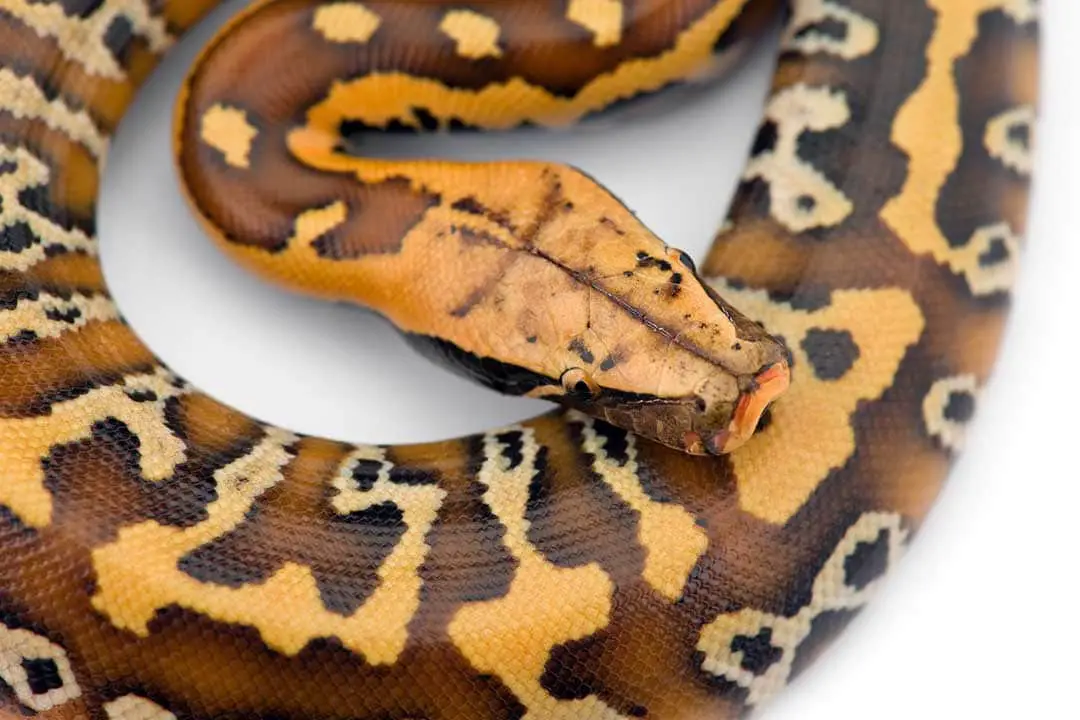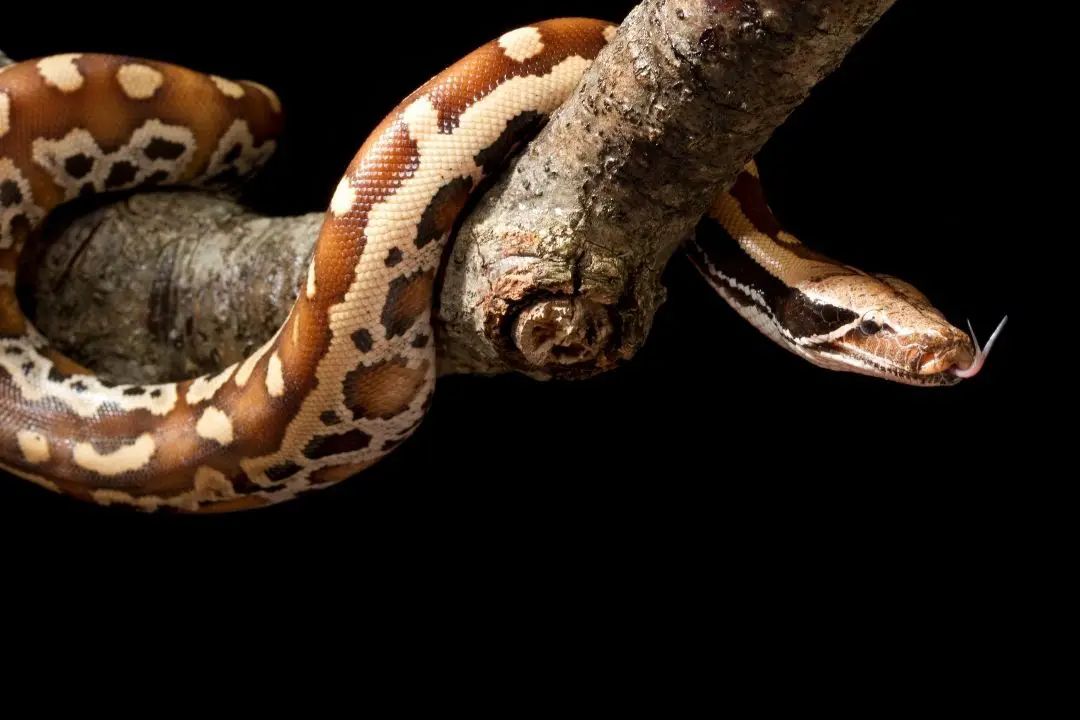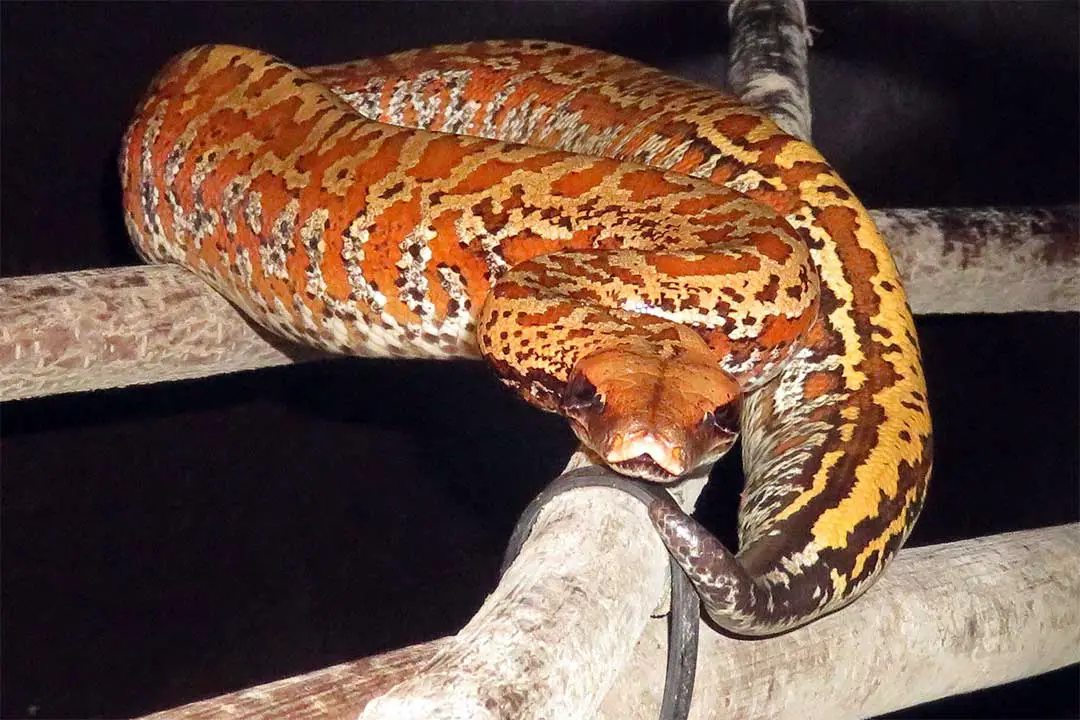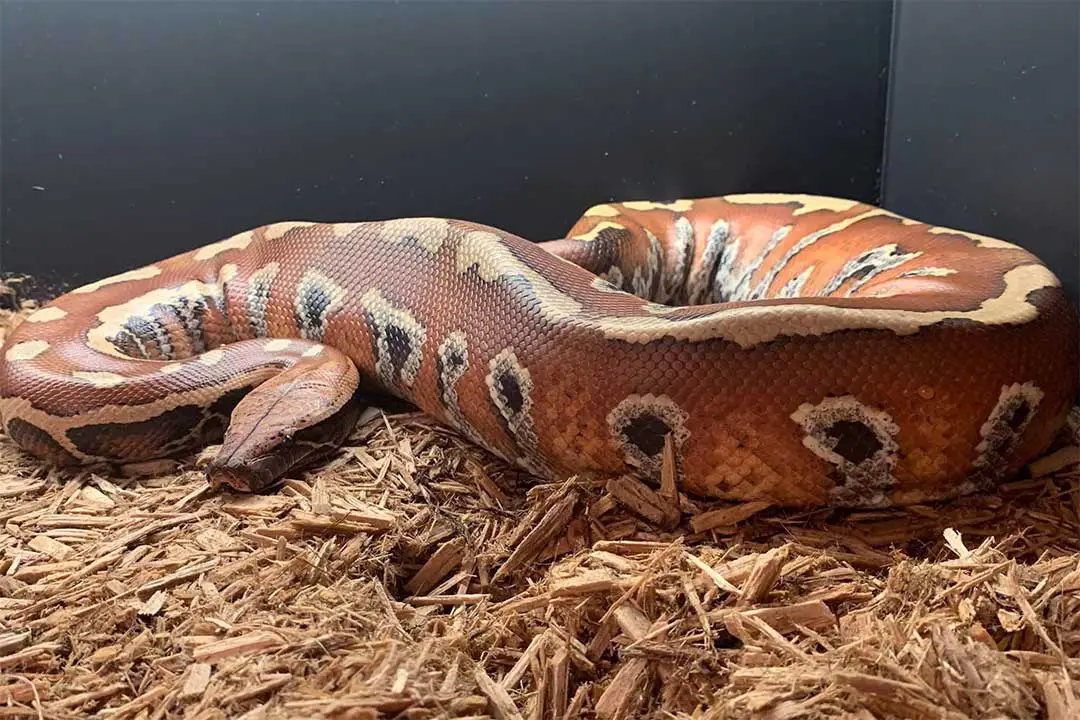Blood pythons (Python brongersmai) are members of the python genus native to South East Asia.
These snakes live in swampy lowlands and some human-cultivated areas such as palm oil plantations.
These snakes were initially famous for being aggressive and unpredictable, but those snakes were wild-caught animals from the skin trade.
Captive-bred blood pythons can make very good pets with docile personalities as adults. Read on to learn how to care for these amazing snakes.
Tank Setup
Blood pythons are heavy snakes that need a lot of floor space and humidity. Something like an aquarium with a screen top will not work for this species.
They will lose too much humidity and heat to the glass and open top. Stick with something meant for reptiles that can handle a large, heavy snake.
Try to stick with front-opening enclosures since they are more secure and most will hold humidity better. Make sure your chosen enclosure will fit the large hides and space requirements of this species.
You may hear some breeders say that you can have an enclosure that is too large. This isn’t entirely true. Your enclosure likely is too open, not too large.
Adding artificial plants and branches along with plenty of hides will make your snake feel secure and allow it to get exercise.
Enclosure
Blood pythons are not the longest snakes, but they are very heavy. An adult can weigh 20 pounds.
This means you need an enclosure that can handle a heavy, powerful snake. You should also make sure the enclosure can handle holding that much weight.
Look for something sturdy with plenty of floor space. You will want something that hangs onto humidity well since these snakes are typically found in humid areas.
Remember, these snakes are very head shy, so you cannot have an enclosure where you approach the snake from above.
They are typically docile if captive-bred, but they have a strong predator response and may bite in self-defense. Stick with a very spacious enclosure that you can easily get the snake out of.
Enclosure for Juvenile Blood Pythons
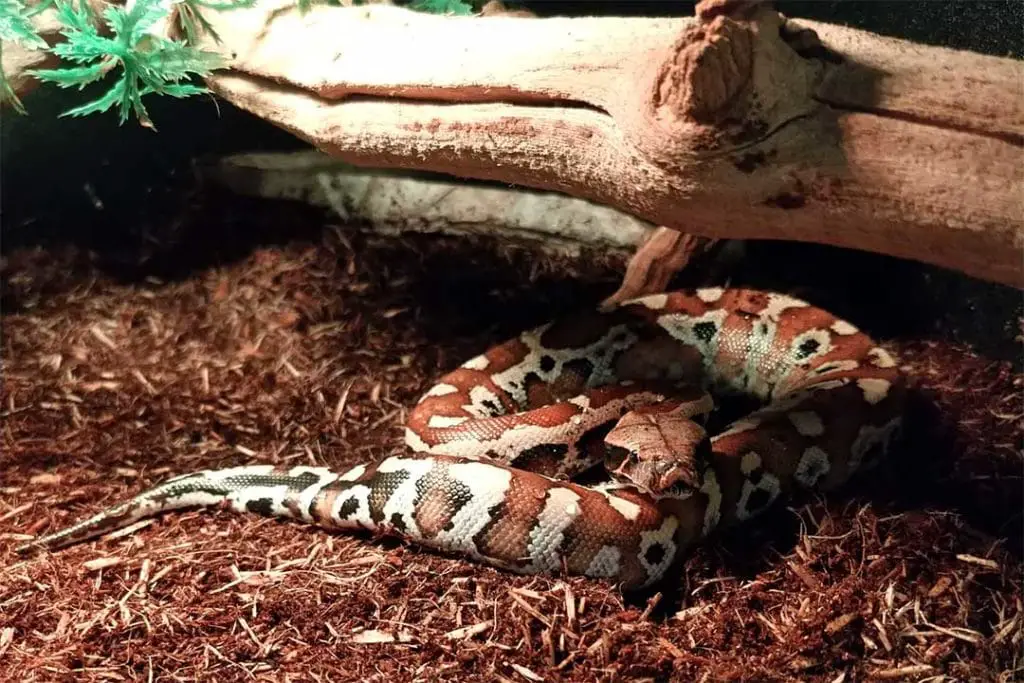
Hatchling and juvenile blood pythons require less space, but far more clutter to feel secure.
A new baby will only be around a foot long when it hatches, but these snakes do grow in length and girth more quickly than you would think.
Babies also need higher humidity, so select something that will hold onto it better while allowing for plenty of ventilation. These snakes are prone to respiratory problems if the ventilation is poor.
For a very young blood python, a 24 inches by 18 inches enclosure is fine and should hold the snake for some time.
This is a good example, but keep an eye on the humidity. Try to stick with enclosures that allow for deep substrate and avoid anything that doesn’t open from the front.
These snakes are very defensive, so you may be bitten. You can use something that is at least 36″x18″ for a juvenile, or move up to an adult enclosure once the snake is getting long enough that it can no longer fully stretch out.
Enclosure For Adult Blood Pythons
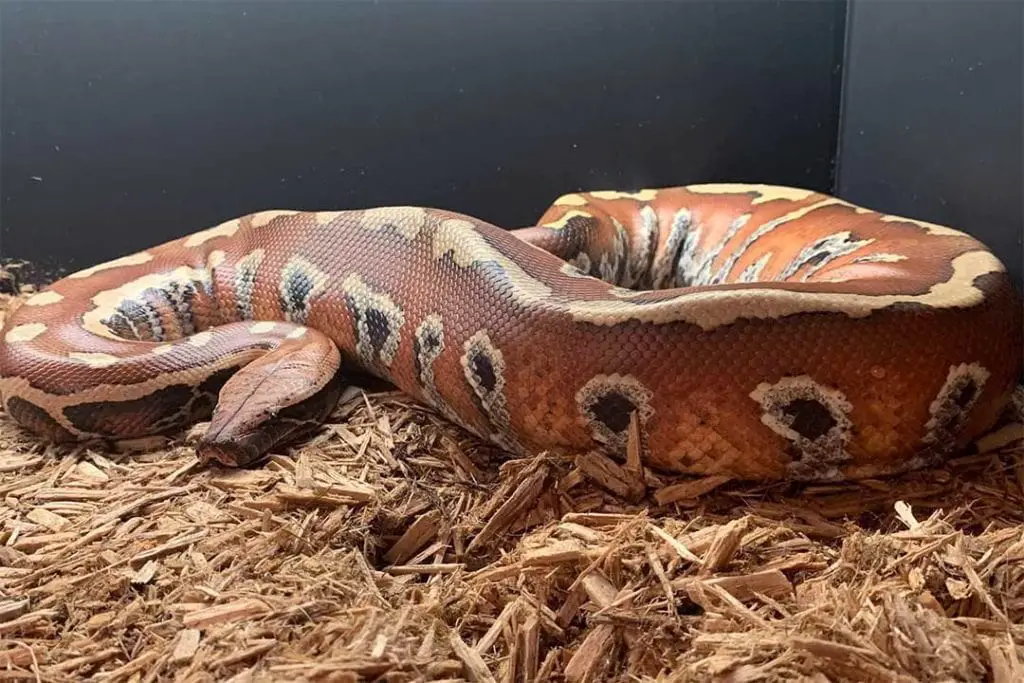
Adult blood pythons are very large animals! They are between 4 and 6 feet in length and can weigh up to 30 pounds.
You need an absolute minimum of 48″x24″x”24″.
A terrarium for a blood python should have secure doors and has plenty of space for these massive adult snakes. If your snake ends up being a giant, go for a larger enclosure.
You need room for two very large hides, a water dish that will fit the snake, and branches since many blood pythons like the option to climb.
While these snakes do need to feel secure, you can accomplish this by using backdrops in your blood python enclosure to help make the snake feel more secure.
Even opaque paper on the outside of the enclosure will help the snake feel safe. Make sure you fill any space with greenery as well.
Just make sure anything you select is reptile-safe and can handle these massive animals. You will also want to secure any decorations well since these heavy animals can tip things over very easily.
Substrate
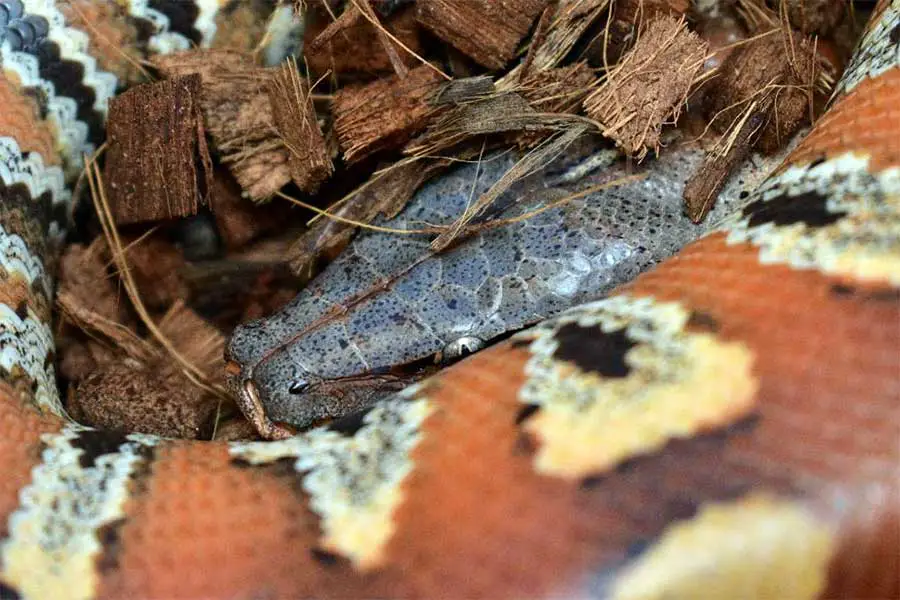
Blood pythons need a lot of humidity.
Most substrates not made for wet cages can mold in higher humidity. Paper towels will work for quarantining a new snake, but you will need to move the snake to something else.
Ideally, pick something that allows the snake to burrow.
Reptichip is a great option since it will not get moldy and will help retain humidity. Remember, these snakes live in swampy areas, so they prefer humid substrates.
You can also select something like repti-soil or similar options if you intend on planting the enclosure or want a bio-active setup.
Aspen should not be used since it may mold, and avoid cedar and pine since the oils can cause illness in snakes.
Since these snakes do burrow, a layer of paper towel or reptile paper on the bottom of the enclosure under the other substrate is a good idea.
This helps with clean-up and makes sure your snake can’t lay directly on under tank-heating elements. Make sure you use at least 4 inches of substrate so your snake can burrow.
Some snakes may appreciate the warm side having deeper substrate, but you should easily set it up so it crosses all the way across the thermal gradient.
Temperature and Heating
Since blood pythons spend most of their time burrowed or on the floor of the enclosure. You will want an under-tank heating option to provide belly heat. Blood pythons should be kept within a 82-85 degrees temperature on the warm side.
Heating your enclosure correctly is a critical part of proper blood python care.
Any higher body temperature, and your snake may become stressed out and aggressive. High ambient temperatures irritate these snakes and make them more likely to bite.
This is a good option for a heat mat.
You will want to cover about a third to half of the enclosure, depending on how difficult it is to keep the temperatures stable.
This must be plugged into a thermostat to make sure it doesn’t get too hot:
Monitor the temperatures with a thermometer with multiple sensors placed in the hides and a temperature gun. You should also observe where your snake spends its time to regulate its own body temperature.
If it is always on the warm side, you need to turn up the temperature. If it never leaves the cool side, it is too warm for your snake.
Adjust the temperatures until your snake is using the whole enclosure freely throughout the day. Heating bulbs or overhead heaters are popular to provide supplemental heat, but they can dry out the enclosure. Only use them if you cannot maintain temperature with just the mat.
Lighting
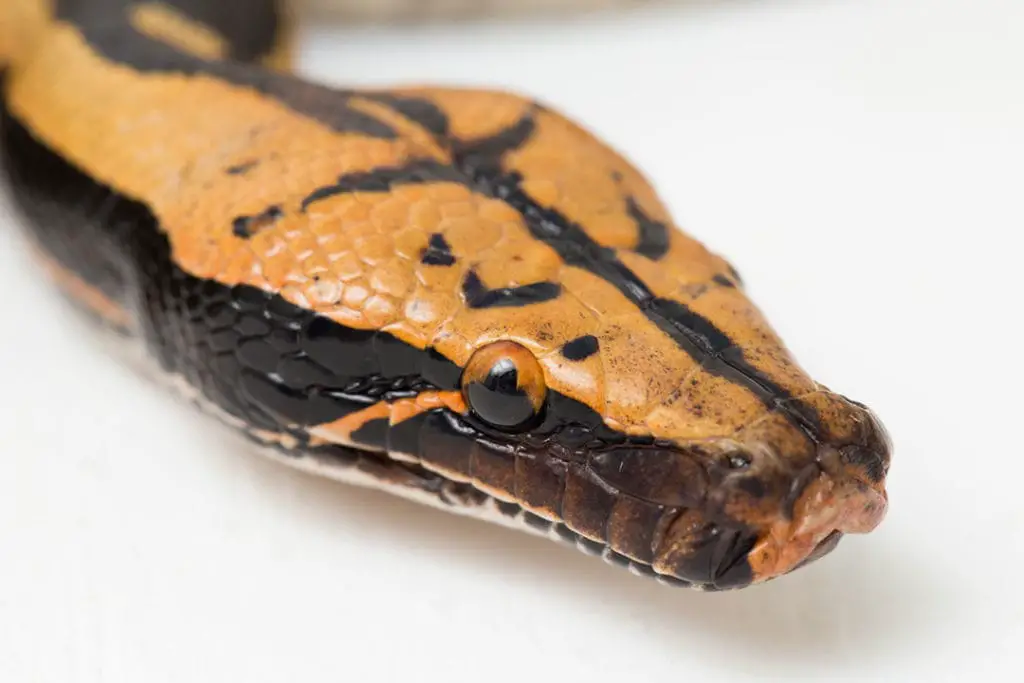
Blood pythons do not require any special lighting as they are nocturnal.
You can use any lighting to make your pet more visible, so long as it doesn’t heat the enclosure.
Make sure you have the light on a timer to simulate a day/night cycle. 10 to 12 hours on is the maximum.
Shelter or Hide box
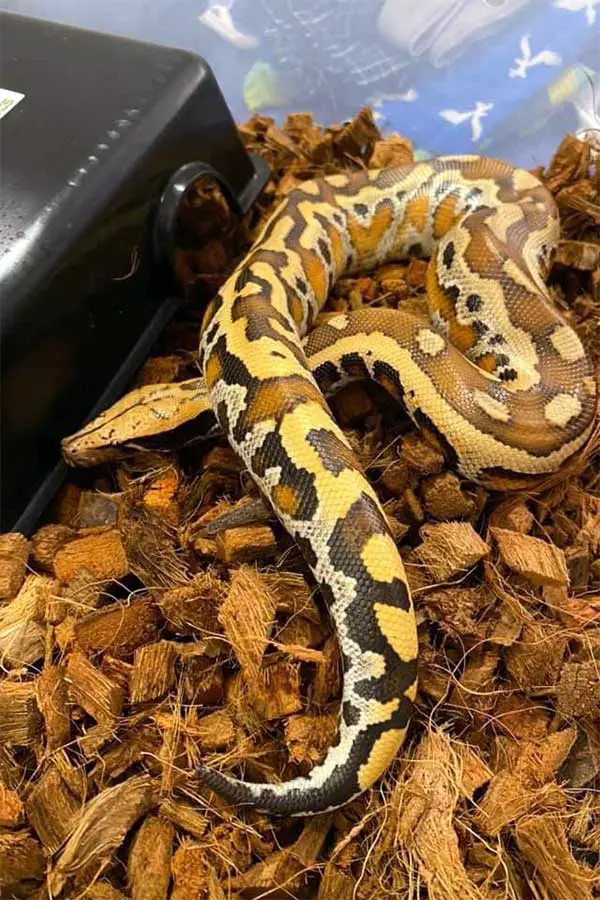
Proper shelter is essential to your snake’s health and happiness. You will want a hide that can hold your entire snake without much extra space so it feels secure.
You will want at least one placed on each side of the hide. You should also have a sturdy branch or two for climbing and some greenery or other clutter so your snake feels hidden.
If you go with a glass enclosure, cover three of the sides with something opaque so your snake feels secure.
It will also make a nice option for a damp hide. You can use a hide like the one above, or more decorative options if your snake will fit.
Large ceramic pots with a hole cut into it that is about 1.5x larger than your snake’s widest point or cardboard boxes make good hides if you are having trouble finding something that will work for your snake.
Just make sure it is opaque and easy to clean or be thrown out and replaced easily.
Water
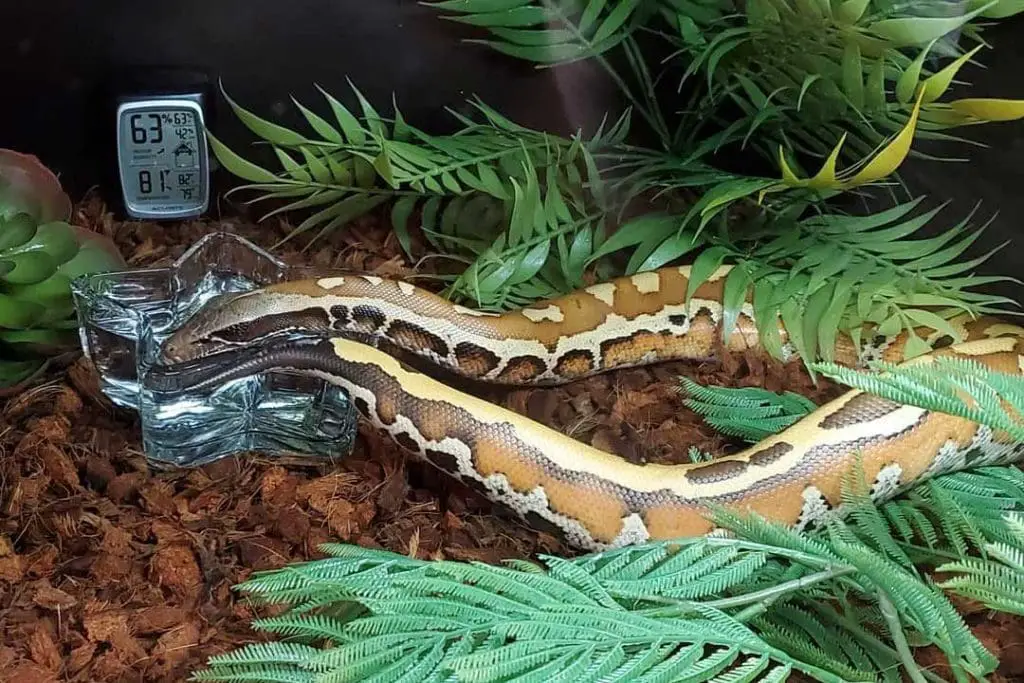
All snakes need constant access to fresh water. It helps keep up humidity, provides your pet with drinking water, and is even a soaking pool for your blood python’s enclosure.
You want a water dish that is easy to clean, will hold the whole snake, and won’t be tipped over easily.
This is a good option for young snakes, but you will need something bigger for an adult.
Humidity
Humidity is another big issue for blood pythons.
Blood Pythons need to be kept at 60-70% humidity or your snake will become dehydrated. They may have trouble shedding as well.
A bad shed can result in injury, infection, or even death if it is bad enough. Keep up the humidity with regular misting.
You can use sphagnum moss placed in a hide on the warm side to help your snake stay hydrated.
This should be offered when you see the first signs of shedding. This is also a good idea if you have trouble keeping up the humidity.
You can also try covering part of the screen if your enclosure is consistently too dry.
Enclosure Maintenance
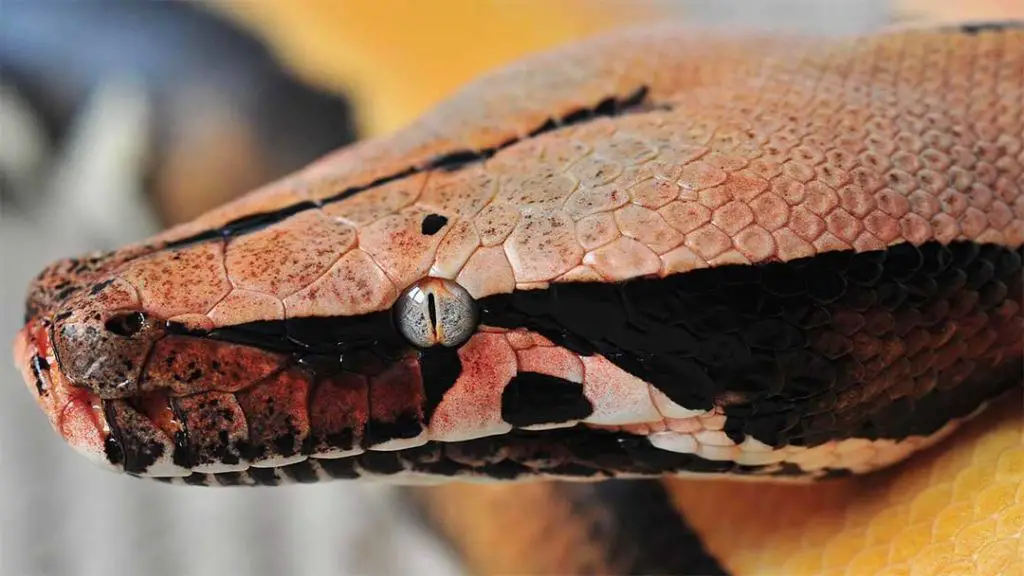
Keeping a clean enclosure is essential for your blood python’s health. Allowing waste to build up can cause infection and other illnesses.
Every day, check your blood python’s enclosure for soiled substrate and feces. This should be cleaned out and the soiled substrate should be replaced. You will also want to give your snake fresh water.
If it has defecated in the bowl, be sure to sanitize it thoroughly. You should fully sanitize the water bowl once a week.
Once a month, you need to completely clean the enclosure. The first step is to turn off the heating and lighting. Next, catch your snake and put it in a temporary enclosure.
You should have one ready for when you clean the enclosure or for vet visits. This can be a plastic tote with a secure lid and air holes, or a special reptile carrier so long as it will fit these heavy bodied snakes.
Next, remove all the decorations and hides. Dispose of anything that can’t be sanitized and set aside the rest for cleaning. Remove all the substrate and scrub the enclosure down.
Be sure to use a reptile-safe cleaner. Also, be sure to never spray cold liquid on hot glass. this may result in the glass cracking from thermal shock.
Once everything is scrubbed and sanitized, leave the enclosure open to fully dry while you clean the hides, water bowls, and other decorations.
Everything should be sanitized so your snake will stay healthy. Once it is all clean and dry, you can replace the substrate. Then, turn on the heating and lights, replace all the decorations, and fill up the water dish.
This is a great time to redecorate and give your snake some enrichment. Once the enclosure is ready, put your snake back and lock up.
Feeding
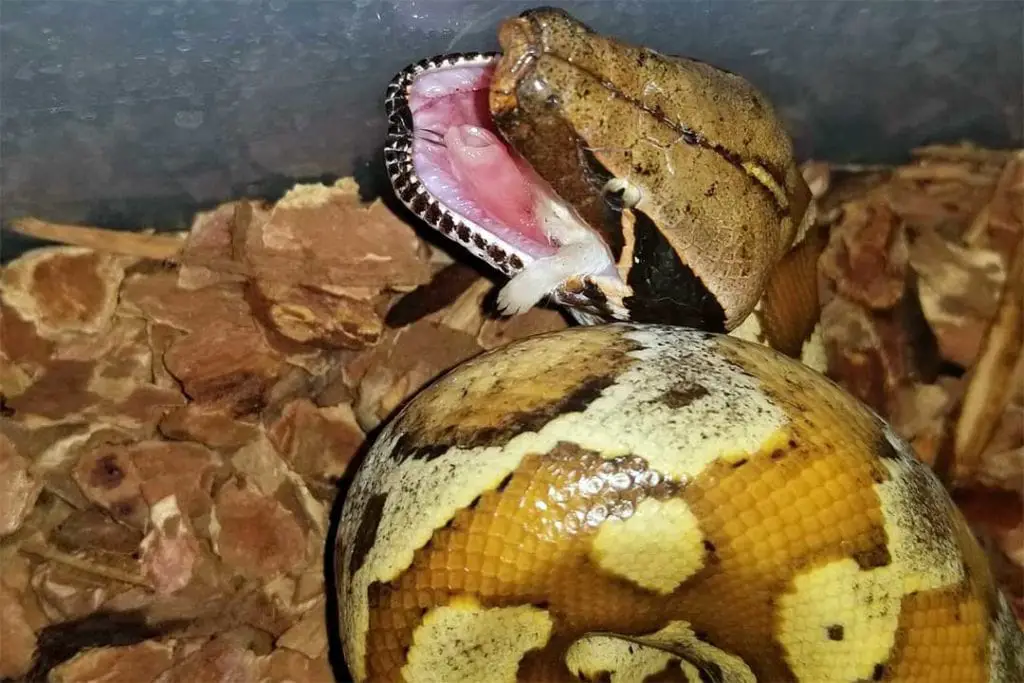
Blood pythons in the wild eat primarily small mammals and birds. Most of their wild diet consists of rodents that they ambush when they come to drink at night.
Your blood python will do well on a diet of rodents offered in the evening.
Type and Size of Prey
Blood pythons in captivity feed almost exclusively on rats from the day they hatch. Some hatchlings may prefer mice, but by the time a breeder sells a snake, it should be established on rats.
You will want a rat that is no bigger than the widest part of your red blood python.
Blood pythons are prone to obesity, so do not feed very large prey.
You may need to experiment to find the right combination of prey size and frequency to keep your snake healthy. Be patient and keep careful track of your snake’s growth by weighing it a day or so before you plan on feeding it.
Frozen Vs Live

Since blood pythons feed exclusively on rats, the frozen vs live food debate is particularly important. An adult blood python will feed on large rats, and rats can fight back.
A live rat can easily kill a blood python if you aren’t careful. Rats are much stronger than you would think, and at best your snake will be chewed up or lose its tail.
Always feed this species frozen prey or otherwise pre-killed if possible.
They may skip a meal or two when they are being switched, but most blood pythons will eat pre-killed prey so long as you warm it to around 105 degrees before you offer it.
Offer it with hemostats or feeding tongs. A reluctant snake can be induced feeding response to strike by poking the rat into the place where the head and neck meet.
This can induce a feeding bite. Pre-killed rats can work for snakes that refuse frozen if you kill the rats right before feeding. A CO2 chamber is the most humane way to euthanize rats to become safe feeders.
Talk to your vet about it or learn how to euthanize the rats safely by cervical dislocation. If you must offer live prey to your snake, you absolutely cannot leave the snake alone.
Always watch the feeding response and interaction until the rat is dead and being consumed. You will need to act fast to keep your snake safe. Wear gloves so you won’t be bitten by your snake or the rat.
How Often to Feed
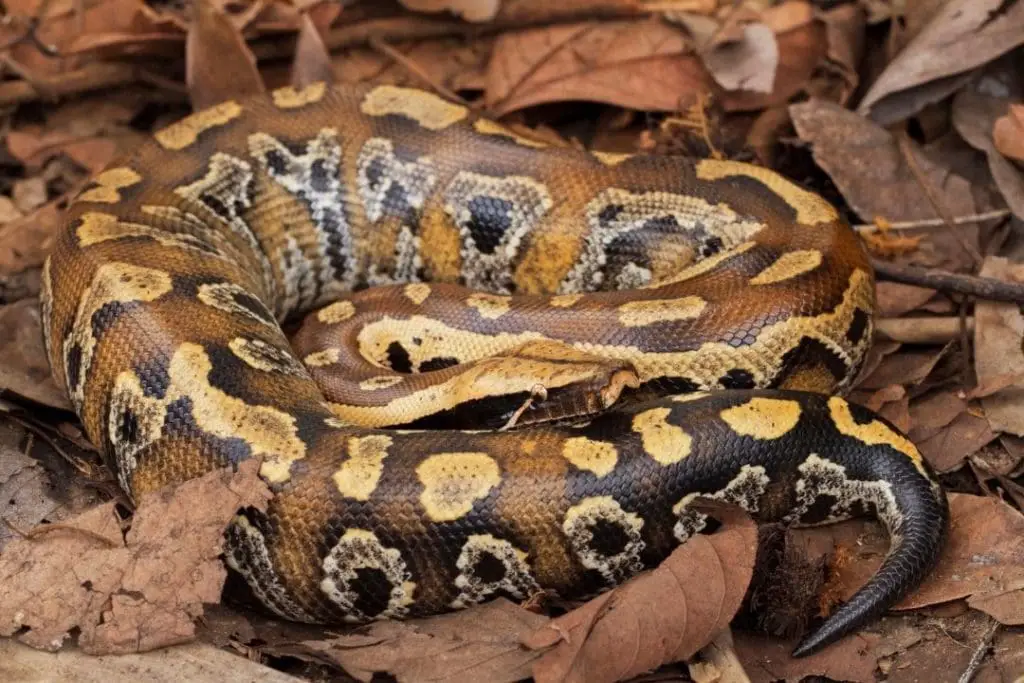
Blood pythons are prone to obesity, so be careful not to feed too often. A healthy blood python is thick, but has an obvious dorsal ridge and gently sloped sides.
- Hatchlings and juvenile blood pythons. will eat an appropriately sized rat once a week.
- An adult blood python will eat every 2 to 3 weeks depending on its metabolism.
Keep an eye on your snake and make sure it isn’t getting too fat. Obesity gives this species major breathing problems and makes females lay bad eggs.
Shedding
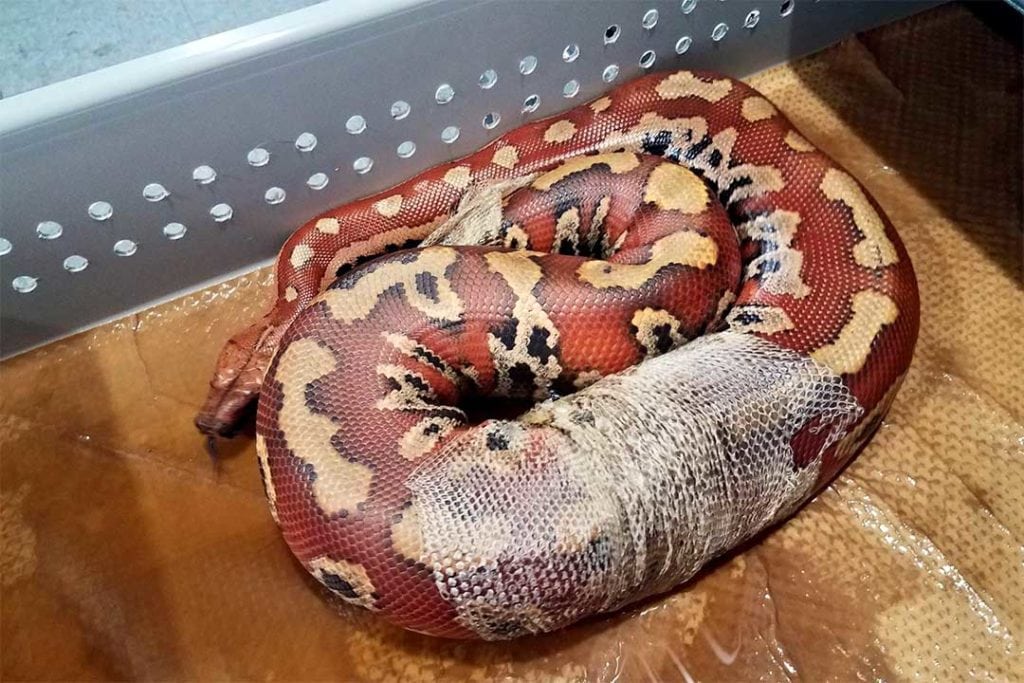
Blood pythons need to shed their old skin to grow.
This process begins when the snake has cloudy eyes and a dull color. At this point, you need to offer a damp hide on the warn side and mist at least once a day.
You may see your snake soaking in its water dish as well. Leave your snake alone during this time, since it won’t be able to see you and may lash out from fear.
The color of the snake should go back to normal, then you will see the snake start rubbing on the branches, hide, and other surfaces to loosen the old skin.
It will crawl out of the old skin once it can. Check this skin to make sure it is intact.
Pay special attention to the eye caps that cover the eye itself and the tip of the tail. If the skin is intact, your snake had a healthy shed.
If not, you need to give your snake a damp hide or a tub with warm, damp paper towels. Leave the snake in for about half an hour and see if you can remove the retained shed.
If it won’t come off easily, try one more treatment. If this doesn’t work, head to the vet as soon as you can. Retained shed can cause illness and infection if left alone.
Hibernation
Blood pythons, like short tailed pythons do not need to hibernate or brumate during the winter. You may see your snake become less active, but this is normal.
Make sure the temperature is stable and offer food less often until they perk up again. Some breeders do cool pythons to help increase clutch size, but you should not do this with a pet.
Handling
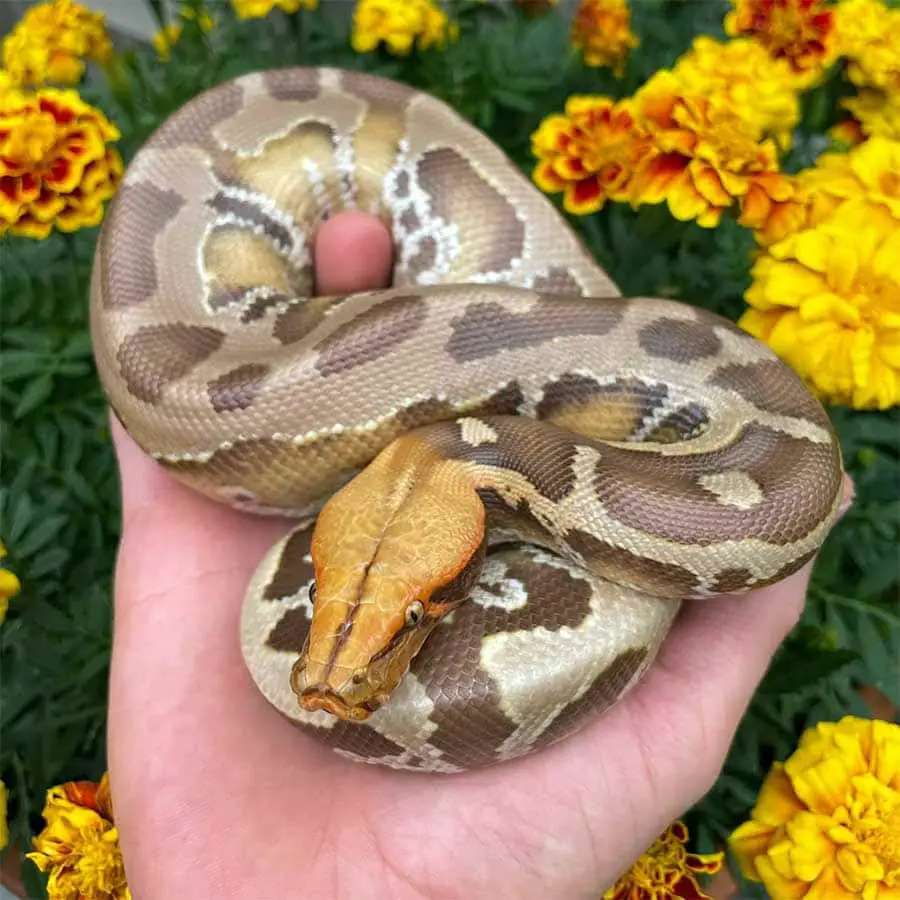
Blood pythons are notorious for being aggressive.
This is a myth. Blood pythons that are captive-bred and raised from a responsible breeder are not particularly aggressive.
Never buy a captive hatched or wild-caught animal, since they are more likely to be defensive or prone to disease than a properly bred snake.
Most blood python and short tailed pythons breeder select for docile temperament, so going with a breeder means you will be more likely to have a tame snake, and you will also have many different blood python morphs available when buying captive bred.
Given that these animals end up weighing over 20 pounds, you want a calm pet.
When it comes to handling, you should start off hatchlings and juveniles with short, gentle handling sessions.
Stick with just a few minutes and return the snake when it is calm.
Start off by making sure your snake is awake. Try to approach in the early morning or evening, when your snake is less likely to be asleep.
You can use a snake hook to gently touch your snake so it knows that it is handling time, not food time.
Approach your snake from the side and lift it either with a hook or your hand under the middle of the body. Once your snake is out, support as much of the body as possible.
Do not squeeze your snake. Young snakes may thrash or bite, but do not drop the snake or react poorly.
Let your snake calm down and then keep it out for only a few minutes before putting it back. Try to keep handling sessions to only 2 or 3 times a week so you don’t stress out your snake.
If you keep this up, your adult snake should be docile and easy to handle. Once your snake gets heavy, make sure you have an assistant around just in case.
They are very strong and heavy animals so if they do react poorly, you have help. Once again, they are not aggressive, this is just common safety for heavy snakes.
Common Issues
Here is a brief FAQ on common blood python problems. Read on and feel free to ask questions if your question isn’t covered.
My Blood Python Won’t Eat
Blood pythons are typically very good feeders. The most common reasons for going off its food are stress and illness. Check your temperatures, humidity, and leave your snake alone for about 2 weeks before you try feeding again.
Check for signs of infection, changes in color to the skin, or excess mucus. Injuries to the mouth and difficulty breathing are also signs your snake needs to go to the vet.
My Blood Python is Aggressive
Blood pythons and borneo short tailed pythons are not typically aggressive.
An aggressive snake will charge you. Defensive snakes flee or warn before a bite. Check that the temperatures aren’t off and your snake isn’t stressed.
Wild-caught specimens are more reactive and easily stressed than captive breeding ones. Illness can also cause defensive behavior, so look into a vet visit if your snake is grumpy for a long time.
My Blood Python Regurgitated
Regurgitation is a sign of stress. In the wild, blood pythons will regurgitate a meal to escape a predator.
Never handle a snake right after a meal. Wait at least 48 hours. If the prey is too large, your snake may regurgitate. Try offering a smaller meal in 2 weeks.
Illness
Blood pythons are terrestrial snakes, prone to many illnesses. Look out for heavy breathing and excess mucus as a sign of a respiratory infection. Look for signs of infection like pus and skin changes.
Also look out for mites. They are black and about the size of a poppy seed. You may see them floating in the water dish since infested snakes will soak frequently.
Look for changes in urates and feces to check for parasites. Any changes means that your snake needs a vet visit with your local reptile veterinarian.
Sources
Harvest Effects on Blood Pythons in North Sumatra – Wildlife Society
Blood python Description – Utah’s Hogle Zoo
Python Brongersmai – Wikipedia
Conclusion
Blood pythons make amazing pets. Buy a captive bred animal from a breeder and you should enjoy your pet for decades to come.
If you have any questions or comments, please leave them below.
